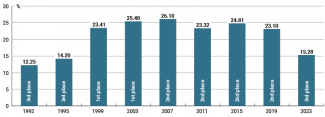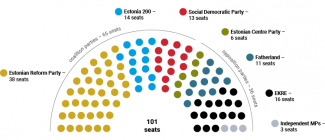The gradual break-up of the Estonian Centre Party
On 29 January, Jüri Ratas, Estonia’s former long-time prime minister (2016–2021) and the leader of the Estonian Centre Party (Eesti Keskerakond, CP) until September 2023, announced his decision to join the right-wing Fatherland party (Isamaa). As the official reason for this move he cited differences of opinions between him and the party’s new leadership, especially its new leader, Tallinn’s mayor Mihhail Kõlvart. Other individuals who have left the Estonian Centre Party in recent weeks include a group of politicians linked with the former prime minister, including ministers, local government officials and mayors. The party has been in opposition since the break-up of Kaja Kallas’s first government in 2022. Should more MPs decide to leave the party’s ranks, the organisation may become reduced to a local political party, which will mainly be active in several local government bodies in Tallinn.
Until recently, the CP was among Estonia’s most important and oldest political forces. It was established in 1991 and for many years had acted as the main rival to the Estonian Reform Party (Eesti Reformierakond) in the contest for power. The party’s founder Edgar Savisaar (who died in 2022) was one of the most influential and at the same time most controversial Estonian politicians. He was accused of corruption and links with representatives of the Russian elite, as well as other crimes. In the late 1980s and early 1990s he co-founded the Popular Front of Estonia, which contributed to the country regaining independence. When an independent Estonian state was reinstated in August 1991, he was appointed its first prime minister (he served in this post until January 1992), and later served as a minister and in 2007–2015 as Tallinn’s mayor.
Commentary
- For a long time, the CP was supported by residents of small towns and representatives of the Russian-speaking population. Over the last two years, mainly following the Russian invasion of Ukraine, conflicts within the party ranks were exacerbated. The organisation had problems adjusting itself to the new polarisation triggered by the war, and its efforts to position itself as a party of social consensus were no longer relevant. Similarly, its attempt to carry out an internal transformation and to devise a new narrative to hold the party together failed. The wing linked with Ratas has viewed the CP as a more liberal party appealing to the Estonian electorate, whereas Kõlvart’s group is more conservative and targets the Russian-speaking electorate. As a result of these differences and other factors, the party obtained a poor result in the 2023 election (it came third and won 15.3% of the vote). This was followed by Ratas’s resignation as party leader; Kõlvart succeeded him in September 2023.
- The outflow of the Estonian Centre Party’s members, which has been ongoing in recent weeks, represents a continued decline in its level of support and is affecting the balance of power in domestic politics. The centre group in the Estonian parliament (Riigikogu) has so far lost 10 out of the 16 MPs it elected in the recent election. Some of these MPs have joined the opposition, while others have moved into other parties of the ruling coalition. Four have joined the Social Democratic Party (Sotsiaaldemokraatlik Erakond); these include Tanel Kiik, a popular politician and a minister in 2019–2022, and Jaak Aab, who has served as a minister on multiple occasions. Maria Jufereva-Skuratovski has joined the Estonian Reform Party. This has raised the number of ruling coalition MPs in the 101-seat Riigikogu from 60 to 65. Three former CP MPs, including Ratas, have joined Fatherland, while another two remain unaffiliated. The electorate will most likely follow the decisions of these MPs and will vote either for the Social Democrats or, to a lesser degree, for Fatherland. In the fourth quarter of 2023, the CP’s level of support declined from around 14% to 11%.
- A reshuffle should also be expected in the local government structures in Tallinn. The current ruling alliance made up of the CP and the Social Democrats may be replaced by the present opposition parties. A reshuffle in Tallinn would require support from the Social Democratic Party, which seems realistic because this party has repeatedly suggested that there should be a change in the political group which currently rules the capital. A coalition composed of many different parties such as Fatherland, the Social Democratic Party, Estonia 200, the Estonian Reform Party and former CP members, could take power. This would spell an end of two decades of CP rule in Tallinn. Between 2005 and 2021 the party ruled the capital city on its own, and in later years it formed an alliance with the Social Democratic Party. The local government in the capital city is an influential element of domestic politics. Tallinn is inhabited by a third of Estonia’s population and generates more than 50% of its GDP.
Chart 1. Support for the Estonian Centre Party in parliamentary elections held since Estonia regained independence

Source: Valimsed.ee.
Chart 2. Distribution of political forces in the Estonian parliament

Source: ERR, Riigikogu.





